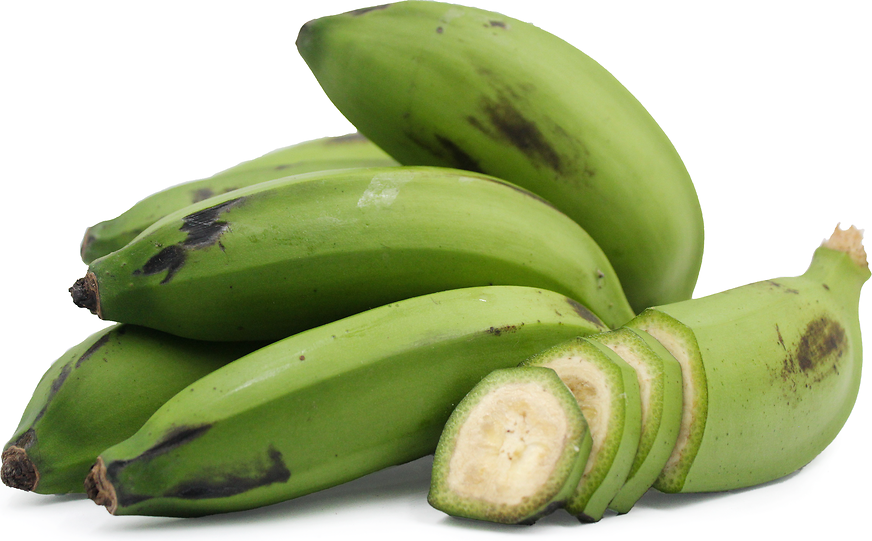


Guineo Bananas
Estimated Inventory, 1 Lb : 0
Description/Taste
Guineo bananas are small to medium-sized fruits, averaging 15 to 20 centimeters in length, and have an elongated, curved to straight, cylindrical shape with angular edges. The peel is semi-thick, smooth, waxy, and dark green when young, maturing to a golden yellow hue when ripe. The peel is also stiff and tightly adhered to the flesh when green, sometimes bearing black marks and spots due to external damage. Underneath the peel, the flesh is firm, cream-colored to pale pink, and dense with a starchy consistency. Guineo bananas must be cooked when unripe and develop a soft, creamy texture with a neutral, subtly sweet flavor. The fruits can also be left to fully ripen, allowing the starch in the flesh to convert into sugars, creating a sweeter taste.
Seasons/Availability
Guineo bananas are available year-round.
Current Facts
Guineo banana is a general descriptor used to encompass many different varieties of unripe bananas belonging to the Musaceae family. Throughout South and Central America, names for bananas are often used as a blanket term for multiple cultivars in an effort to simplify the buying process. Guineo banana is used to describe green bananas that are smaller in size than plantains and have a starchy consistency. The fruits are primarily utilized in cooked applications and have become a staple ingredient in South American cuisine, readily found in local markets at affordable prices. Guineo bananas are also known as Colicero bananas, Topocho bananas, and Cachaco bananas and are a filling, nutritious ingredient used in soups, side dishes, appetizers, and main dishes.
Nutritional Value
Guineo bananas are an excellent source of manganese to help activate enzymes for optimal metabolism, vitamin B6 to help create red blood cells, potassium to balance fluid levels within the body, and vitamin C to strengthen the immune system. The bananas also provide a good source of fiber to regulate the digestive tract and contain lower amounts of vitamins A and E, phosphorus, iron, magnesium, and copper. In South America, Guineo bananas are used as a natural ingredient to improve digestion, reduce symptoms associated with irritable bowels, and maintain blood sugar levels.
Applications
Guineo bananas are primarily utilized young and green, incorporated into cooked applications such as frying, boiling, baking, and grilling. The bananas contain a starchy, firm texture when raw, making them unsuitable for fresh consumption, but when they are cooked, they develop a soft consistency and neutral flavor to complement accompanying flavors. Guineo bananas are popularly sliced and boiled in soups and stews with meats, vegetables, and aromatics to create a filling meal. The bananas are also boiled and sauteed with onions, spices, and peppers to make a pickled side salad. In Colombia, Guineo bananas are sliced, fried, and smashed into the well-known appetizer patacon. They are also are boiled, mashed, and mixed with refrito to make cayeye, a famous Colombian breakfast served with fried eggs, cheese, and protein. Guineo bananas pair well with meats such as beef, pork, and poultry, seafood such as fish, crab, and shrimp, aromatics such as scallions, garlic, onions, cilantro, and chile peppers, potatoes, yucca, squash, corn, peas, olives, and avocado. Whole, unpeeled Guineo bananas will keep up to one week at room temperature or 8 to 10 days when stored in the refrigerator. The bananas can also be peeled, and the flesh can be frozen in sealed containers for 6 to 12 months.
Ethnic/Cultural Info
Guineo bananas are a staple ingredient in Colombian cuisine as the fruits are widely grown, easily found in markets, and are an inexpensive, filling ingredient. The starchy bananas are often sold through small, locally-owned restaurants and street food vendors throughout major cities, eaten during any meal or as a snack. Outside of metropolitan areas, the bananas are also strongly associated with Llaneros cuisine, a tropical plain region in Colombia known for its vast grasslands, savannas, woodlands, and cattle ranches. Llaneros are Colombian cowboys, and their cuisine is traditionally hearty to keep them full as they undergo long journeys on horseback and tend to cattle in the fields. Fried Guineo bananas are a favorite snack brought on the long trips as it does not require refrigeration and has a filling nature. The bananas are also traditionally served at breakfast and lunch in fried preparations or in soups and stews.
Geography/History
Guineo bananas are descendants of banana varieties native to Southeast Asia that were spread around the world through explorers, migrating peoples, the slave trade, and merchant ships. The ancient fruits were introduced to the New World sometime in the 16th century through Spanish explorers, and the fruits were planted throughout Central America, the Caribbean, and the northern regions of South America in both tropical and subtropical climates. In Colombia, Guineo bananas are cultivated in the Andean region, able to withstand some dry weather, making them one of the top exported fruit crops. The bananas are mainly grown in the Turbo, Chigorodo, and Apartado departments of Colombia and on a smaller scale in Magdalena and Guajira, widely sold at local markets.
Recipe Ideas
Recipes that include Guineo Bananas. One















